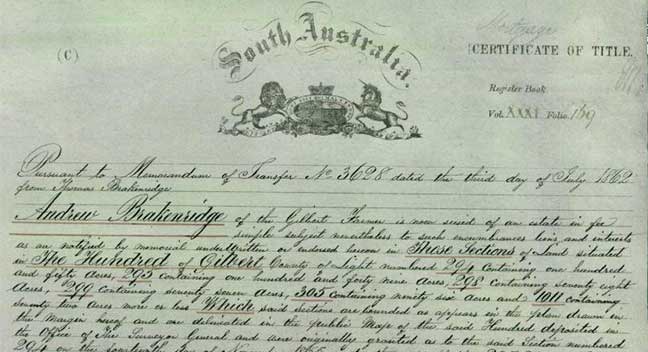In 1834 the British Parliament passed the South Australia Act, which created the province of South Australia and defined the province as being “…that part of Australia which lies between the meridians of the one hundred and thirty-second and one hundred and forty-first degrees of east longitude, and between the southern ocean and the twenty-six degrees of south latitude, together with all and every the islands adjacent thereto, and the bays and gulphs.”[1] Two years later on the 28th December 1836, Governor Hindmarsh arrived at Holdfast Bay, from England, to proclaim South Australia.
The group of colonists, who arrived with Governor Hindmarsh, immediately found trouble with blocks of land that had been purchased, not being available. Colonel William Light, the first Surveyor-General for SA, famous for designing the layout of the streets and parks in Adelaide, was under pressure, with lack of staff and equipment to manage the high demand of subdivisions and land sales to fresh immigrants arriving.
The system of recording land ownership at the time was adopted from the English Common Law system, by which records of land transactions were recorded by way of deeds, mortgages and leases to which all needed to be present to prove ownership of land.[2] The bundle of documents was usually tied together with a pink cotton ribbon, perhaps being cause for the term “Red Tape”.[3] This left holes in the chain of ownership, if a deed was missing, the title was in doubt. Naturally as a result of this ambiguity, the process of transferring the land to the purchaser was an expensive process, as the purchaser’s solicitor would spend many hours researching and examining documents.
In 1857 Sir Robert Richard Torrens, Colonel Treasurer and Registrar General, introduced the Real Property Act 1858 which became known as the Torrens Title System and is still used in many parts of the world today. The Torrens System involves transferring land ownership through a registration of title rather than through deeds. The registration of interests to a title (being that of transfers, mortgages, leases, etc) are recorded on a single certificate and are guaranteed by the State. The Certificate of Title was prepared in duplicate with one being passed to the owner of the property and the other remaining with the Registrar General in a series volumes and folios.
Sir Torrens adopted the idea of the Torrens System from the same method that was used to sell ships, whereby a single document gave continuing proof of ownership through a shipping manifest, which was held by Lloyds of London.[4]
Certificates of Title were originally produced from Parchment, which is a stretchy, dried sheepskin that lasted much longer than paper. Each dealing was entered on the Certificate of Title and the last transferee name was the Registered Proprietor of the land.
Over the years the system has modernised to the current electronic registration system, whereby each dealing is recorded in an electronic register and noted on an updated Certificate of Title.
There are no longer duplicate Certificates of Title in South Australia and all dealings are recorded electronically. Owners can order copies of their Certificate of Title from the Lands Titles Office, now known as Land Services SA.
We thank Sir Robert Richard Torrens for his contributions to the intricate manner by which title registration is handled today and throughout history. As Conveyancers, we are proud to be South Australian.
Do you have questions about your Certificate of Title? You can get in touch with us for more information.
[1] “Transcript of the South Australia Act, 1834” (PDF). Museum of Australian Democracy at Old Parliament House. Retrieved 6 June 2019.
[2] Sa.gov.au https://www.sa.gov.au/__data/assets/word_doc/0019/14167/Overview_of_the_Torrens_Title_system_video_transcript.doc
[3] http://searchlink.com.au/land-titles/the-history-of-australian-torrens-land-titles-and-procedures/
[4] http://searchlink.com.au/land-titles/the-history-of-australian-torrens-land-titles-and-procedures/




